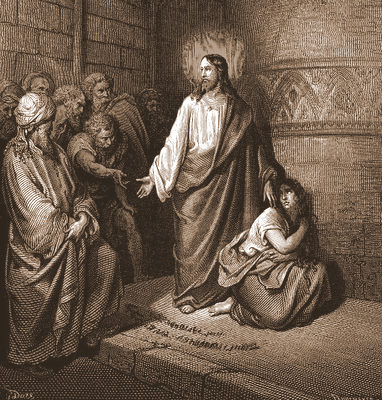… Jesus went to the Mount of Olives . Early in the morning he came again to the temple. All the people came to him and he sat down and began to teach them. The scribes and the Pharisees brought a woman who had been caught in adultery; and making her stand before all of them, they said to him, "Teacher, this woman was caught in the very act of committing adultery. Now in the law Moses commanded us to stone such women. Now what do you say?" They said this to test him, so that they might have some charge to bring against him. Jesus bent down and wrote with his finger on the ground. When they kept on questioning him, he straightened up and said to them, "Let anyone among you who is without sin be the first to throw a stone at her." And once again he bent down and wrote on the ground. When they heard it, they went away, one by one, beginning with the elders; and Jesus was left alone with the woman standing before him. Jesus straightened up and said to her, "Woman, where are they? Has no one condemned you?" She said, "No one, sir." And Jesus said, "Neither do I condemn you. Go your way, and from now on do not sin again."

“He bent down and wrote on the ground.” I realize that we are all in different places. Our thinking and reading these reflections are through the different lenses of our own experience. I think that the sentence about him writing on the ground jumps out because, to me, it doesn’t otherwise belong. Why did he write on the ground? Why is it important to mention?
I would like to make the suggestion that Jesus gives us the image of a challenge, as if he were drawing a line in the sand saying, “Let anyone among you who wants to stone her come cross this line – and then you will deal with me!” We can almost see the Jesus meek and mild puff out his chest for a minute and get tough in order to protect the woman. It must have worked, because everyone dispursed and none were left but her and Jesus.
At the beginning of the passage, I want to yell out, “It’s a trap, Jesus… don’t answer them!” When the woman is brought to him, it's one of their schemes that they use in order to trap Jesus. It's a catch-22. He is doomed either way. The Pharisees are keeping the letter of the law rather than the intent of the law. They want to trick Jesus into going against what is prescribed in the law of Moses, but Jesus uses this opportunity to teach them in a very simple way that the complete law is intended for all – and that all fall short of keeping the law. It obviously works, because they all leave. Instead of condemning another, they turned the condemnation inward and started to think of their own sin.
We, like the Pharisees are quick to condemn and judge the way others act, rather than first look at ourselves. I think that our call today is to be introspective of our outward actions. Examine ourselves, prior to accusing another. Without condemnation, but with forgiveness and guidance, Jesus offers the accused woman another chance. Are we quick to condemn, and want to immediately pick up the stone and right the world, or do we come from a place of forgiveness – having first forgiven ourselves and then extending that forgiveness to others – and offering guidance rather than condemnation?
No comments:
Post a Comment